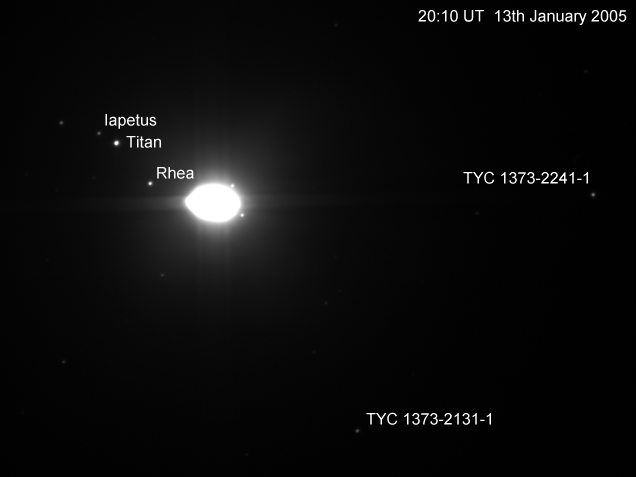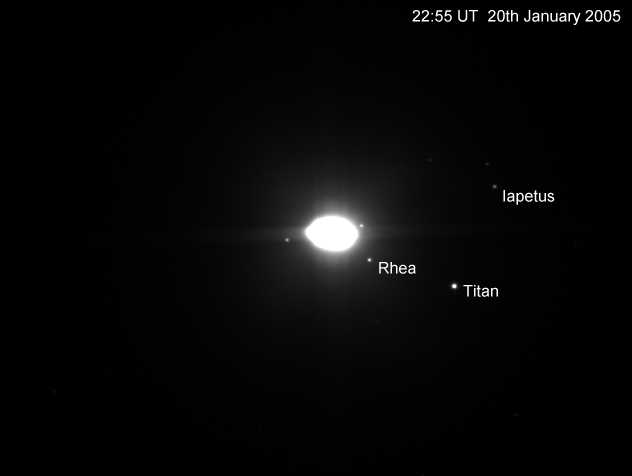
PHOTOMETRY OF THE SATURN SYSTEM
THE "OPPOSITION EFFECT"
January 2005
Dr Anne Verbiscer at the University of Virginia USA put out a request for observations of Saturn's moons around the time of opposition 13/14th January 2005. http://www.astro.virginia.edu/~av4n/SatOpp05.html The near perfect alignment of Sun, Earth and Saturn at this time gives a rare opportunity to measure the "opposition effect", a brightening of an object at opposition, which gives information about the surface characteristics. (On this occasion the alignment is close to perfect. ie as viewed from Saturn, the earth would be seen to transit across the diameter of the sun.)
I decided to attempt some measurements with the SC3 modified webcam, but discovered that accurate photometry of the satellites of Saturn is challenging for a number of reasons.
1. The glare of the the planet makes background subtraction a problem. For this reason I limited the measurements to Titan, Iapetus and Rhea which were further from the planet.
2. The motion of the planet against the background makes it impossible to keep a comparison star in the same field over the several days required for the study. I used two comparison stars which were in the same field as Saturn at opposition on 13th January. I also imaged the suggested comparison star field NGC2420 on each occasion. In this way the later run on 20th January could also be referenced back to the original comparison stars. Differences in sky conditions betwen the two fields could still potentially produce systematic errors as the fields become more widely separated.
3. The wide range of brightnesses from Titan to Iapetus cannot be acommodated satisfactorily within the limited 8 bit range of the webcam. A series of exposures was made using different gains for each satellite imaged.
4. The varying relative positions of the satellites means that their positions on the CCD chip cannot be kept constant across all measurements. As a check, some images were taken with the camera inverted. No significant differences were seen between the two sets, suggesting that the uniformity of sensitivity over the CCD chip is good.
5. Variations in albedo over the surface of the moons means that differences in brightness will occur depending on the face presented and the position of the moon in its orbit. This is particularly true for Iapetus for example. These effects will need to be compensated for in the study to be performed by Verbiscer but it is beyond the scope of these measurements.
Example images and final results from each of the two runs on 13th and 20th January are shown below (North is up). I used an IR blocking filter on the camera. (I need to invest in at least a V photometric filter for future work) Each image is a sum of 50 aligned exposures to provide a high enough count to allow a statistical precision of +-0.05 mag. Repeatability between images within a run was good and averaging the results improved the precision to +-0.03 mag. (To verify the reproduceability between runs, many more runs would be required. Unfortunately I just do not get that many clear nights here to contemplate such a study)


|
OBJECT |
13th January 2005 (during transit window) |
20th January 2005 |
|
Comp A TYC 1373-2241-1 |
Vmag 10.28 B-V 0.48 |
Vmag 10.28 B-V 0.48 |
|
Comp B TYC 1373-2131-1 |
Vmag 10.75 B-V 0.44 |
Vmag 10.75 B-V 0.44 |
|
TITAN |
8.33 CCD (reduced using Vmag) |
8.44 CCD (reduced using Vmag) |
|
RHEA |
9.29 CCD (reduced using Vmag) |
9.85 CCD (reduced using Vmag) |
|
IAPETUS |
10.68 CCD (reduced using Vmag) |
10.53 CCD (reduced using Vmag) |
I await the results from the Verbiscer study with interest. The results here show a small brightening for Titan at opposition which seems reasonable given that surface is effectively invisible because of the atmosphere. There does appear to have been a dramatic increase in brightness of Rhea at opposition however. The brightness of Iapetus increased after opposition but this result will almost certainly be confused by the dramatic two sided albedo whcih makes Iapetus appear significantly brighter when west of the planet.